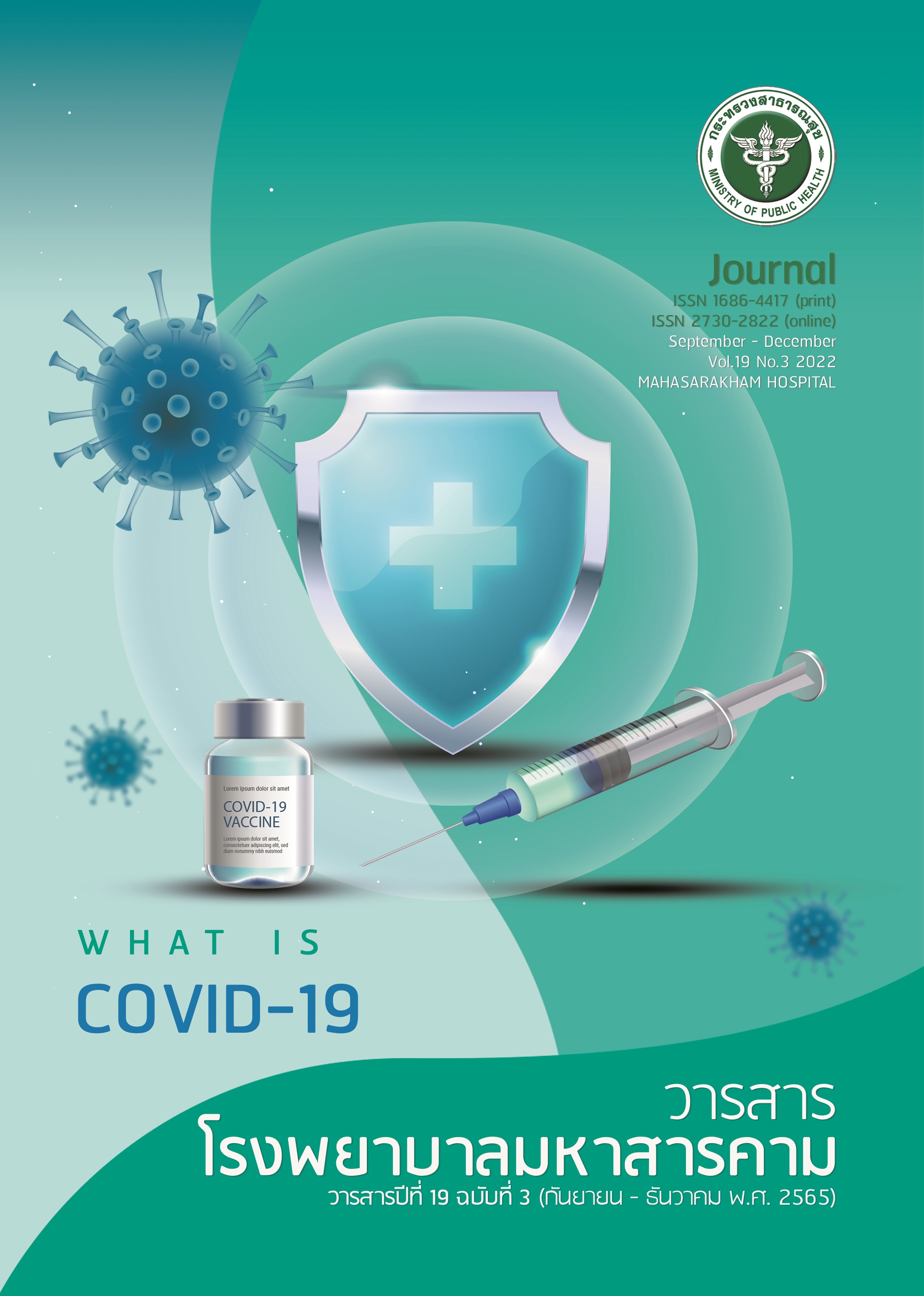ปัจจัยที่มีความสัมพันธ์กับการเกิดปอดอักเสบรุนแรงในผู้ป่วยโรคติดเชื้อไวรัสโคโรน่า 2019
คำสำคัญ:
ปัจจัยที่มีความสัมพันธ์, ปอดอักเสบรุนแรง, โรคติดเชื้อไวรัสโคโรน่า 2019บทคัดย่อ
วัตถุประสงค์: เพื่อศึกษาปัจจัยที่มีสัมพันธ์กับการเกิดปอดอักเสบรุนแรงในผู้ป่วยโรคติดเชื้อไวรัสโคโรน่า 2019 หอผู้ป่วยเฉพาะโรค โรงพยาบาลมหาสารคาม
รูปแบบและวิธีวิจัย: การศึกษาย้อนหลังเชิงพรรณนา (Retrospective descriptive study) กลุ่มตัวอย่างเป็นผู้ป่วยที่ได้รับการวินิจฉัยเป็นโรคติดเชื้อไวรัสโคโรน่า 2019 ที่เข้ารับการรักษา ณ หอผู้ป่วยเฉพาะโรค โรงพยาบาลมหาสารคาม ระหว่างวันที่ 1 มกราคม ถึง 30 มิถุนายน 2565 คัดเลือกกลุ่มตัวอย่างแบบเจาะจงตามเกณฑ์ที่กำหนด ได้จำนวนทั้งสิ้น 198 ราย รวบรวมข้อมูลจากเวชระเบียนโดยใช้แบบบันทึกข้อมูล วิเคราะห์ข้อมูลด้วยสถิติเชิงพรรณนาและสถิติเชิงอนุมานด้วยการวิเคราะห์ความสัมพันธ์โดยใช้สถิติวิเคราะห์ถดถอยโลจิสติก นำเสนอค่า adjusted odds ratio (OR adj) และค่าช่วงความเชื่อมั่น 95% Confidence interval
ผลการศึกษา: กลุ่มตัวอย่างส่วนใหญ่เป็นเพศหญิง (ร้อยละ 57.10) มีอายุเฉลี่ย 58.80 ± 20.38 ปี โดยพบว่า การมีโรคร่วมเป็นโรคเบาหวาน (OR adj = 3.24, 95% CI 1.28-8.21) โรคความดันโลหิตสูง (OR adj = 2.92, 95% CI 1.30-6.57) โรคไตเรื้อรัง (OR adj = 6.50, 95% CI 2.79-15.11) มีระดับค่าความอิ่มตัวของออกซิเจนแรกรับต่ำกว่า 96% (OR adj = 2.73, 95% CI 1.05-7.14) และการไม่ได้รับวัคซีน (OR adj= 10.11, 95% CI 4.12-24.81) เป็นปัจจัยที่มีความสัมพันธ์กับการเกิดภาวะปอดอักเสบในผู้ป่วยโรคติดเชื้อไวรัสโคโรน่า 2019 อย่างมีสำคัญทางสถิติ (p <.05)
สรุปผลการศึกษา: ผู้ป่วยที่มีโรคร่วมโดยเฉพาะโรคเบาหวาน โรคความดันโลหิตสูง และโรคไตเรื้อรัง รวมถึงผู้ป่วยที่มีระดับค่าความอิ่มตัวของออกซิเจนแรกรับต่ำกว่า 96% และไม่ได้รับวัคซีน มีโอกาสและความเสี่ยงต่อการเกิดปอดอักเสบรุนแรง ควรได้รับการดูและเฝ้าระวังอย่างใกล้ชิด
เอกสารอ้างอิง
Rajnik M, Cascella M, Cuomo A, Dulebohn SC, Di Napoli R. Features, evaluation, and treatment of coronavirus (COVID-19). Uniformed Services University Of The Health Sciences; 2021.
Whitaker M, Elliott J, Bodinier B, Barclay W, Ward H, Cooke G, et al. Variant-specific symptoms of COVID-19 in a study of 1,542,510 adults in England. Nature Communications. 2022;13(1):1-10.
Grant MC, Geoghegan L, Arbyn M, Mohammed Z, McGuinness L, Clarke EL, et al. The prevalence of symptoms in 24,410 adults infected by the novel coronavirus (SARS-CoV-2; COVID-19): A systematic review and meta-analysis of 148 studies from 9 countries. %J PloS one. 2020;15(6):e0234765.
Pongpirul WA, Wiboonchutikul S, Charoenpong L, Panitantum N, Vachiraphan A, Uttayamakul S, et al. Clinical course and potential predictive factors for pneumonia of adult patients with Coronavirus Disease 2019 (COVID-19): A retrospective observational analysis of 193 confirmed cases in Thailand. PLoS neglected tropical diseases. 2020;14(10):e0008806.
Nuevo-Ortega P, Reina-Artacho C, Dominguez-Moreno F, Becerra-Muñoz VM, Ruiz-Del-Fresno L, Estecha-Foncea MA. Prognosis of COVID-19 pneumonia can be early predicted combining Age-adjusted Charlson Comorbidity Index, CRB score and baseline oxygen saturation. Scientific reports. 2022;12(1):1-12.
Oliver-Commey JA, Puplampu P, Owoo C, Asare-Boateng K, Yawson AO, Tetteh J, et al. Prevalence of pneumonia by chest x-ray, associated demographic characteristics and health risk factors among COVID-19 patients in Ghana. Ghana medical journal. 2021;55(2):21-8.
Aziz M, Fatima R, Assaly R. Elevated interleukin‐6 and severe COVID‐19: a meta‐analysis. Journal of medical virology. 2020;92(11):2283-5.
Tzotzos SJ, Fischer B, Fischer H, Zeitlinger M. Incidence of ARDS and outcomes in hospitalized patients with COVID-19: a global literature survey. Critical Care. 2020;24(1):1-4.
Brogna B, Bignardi E, Brogna C, Capasso C, Gagliardi G, Martino A, et al. COVID-19 Pneumonia in Vaccinated Population: A Six Clinical and Radiological Case Series. Medicina. 2021;57(9):891.
Schiebler M, Bluemke D. Seeing Is Believing: COVID-19 Vaccination Leads to Less Pneumonia at Chest CT. Radiology. 2022;303(3):693-5.
Bajpai J, Kant S, Verma A, Patwa AK, Atam V, Chaudhary SC, et al. The Severity of COVID 19 Pneumonia in Vaccinated vs. Non-vaccinated Patients in the Second Wave: An Experience From a Tertiary Care Center in India. Cureus. 2022;14(5):1-12.
Murillo-Zamora E, Trujillo X, Huerta M, Ríos-Silva M, Guzmán-Esquivel J, Benites-Godínez V, et al. COVID-19 vaccines provide better protection against related pneumonia than previous symptomatic infection. International Journal of Infectious Diseases. 2022;120:142-5.
Saritsiri S, Mongkolchati A, Suksaroj T. Prevalence of chronic kidney disease and related factors among diabetic patients in primary care, Bangkok, Thailand. Journal of Public Health and Development. 2021;19(1):1-18.
Ingsathit A, Thakkinstian A, Chaiprasert A, Sangthawan P, Gojaseni P, Kiattisunthorn K, et al. Prevalence and risk factors of chronic kidney disease in the Thai adult population: Thai SEEK study. Nephrology Dialysis Transplantation. 2010;25(5):1567-75.
Duan J, Wang C, Liu D, Qiao Y, Pan S, Jiang D, et al. Prevalence and risk factors of chronic kidney disease and diabetic kidney disease in Chinese rural residents: A cross-sectional survey. Journal Scientific Reports. 2019;9(1):1-11.
Syed-Ahmed M, Narayanan M. Immune dysfunction and risk of infection in chronic kidney disease. Advances in chronic kidney disease. 2019;26(1):8-15.
หอผู้ป่วยเฉพาะโรค โรงพยาบาลมหาสารคาม. รายงานสรุปตัวชี้วัด เกณฑ์ และผลลัพธ์การดูแลผู้ป่วย หอผู้ป่วยเฉพาะโรค โรงพยาบาลมหาสารคาม ประจำปี 2564. มหาสารคาม, โรงพยาบาลมหาสารคาม; 2564.
Polit DF, Beck CT, Owen SV. Is the CVI an acceptable indicator of content validity? Appraisal and recommendations. Research in Nursing Health. 2007;30(4):459-67.
Risitano AM, Mastellos DC, Huber-Lang M, Yancopoulou D, Garlanda C, Ciceri F, et al. Complement as a target in COVID-19? Nature Reviews Immunology. 2020;20(6):343-4.
Alipoor SD, Jamaati H, Tabarsi P, Mortaz E. Immunopathogenesis of Pneumonia in COVID-19. Tanaffos. 2020;19(2):79-82.
ดาวน์โหลด
เผยแพร่แล้ว
รูปแบบการอ้างอิง
ฉบับ
ประเภทบทความ
สัญญาอนุญาต
ลิขสิทธิ์ (c) 2022 วารสารโรงพยาบาลมหาสารคาม

อนุญาตภายใต้เงื่อนไข Creative Commons Attribution-NonCommercial-NoDerivatives 4.0 International License.
วารสารนี้เป็นลิขสิทธิ์ของโรงพยาบาลมหาสารคาม






